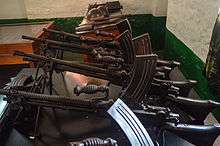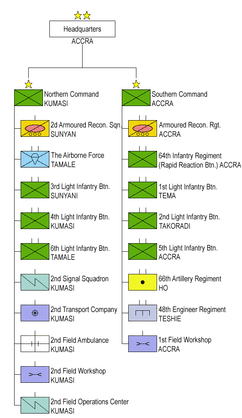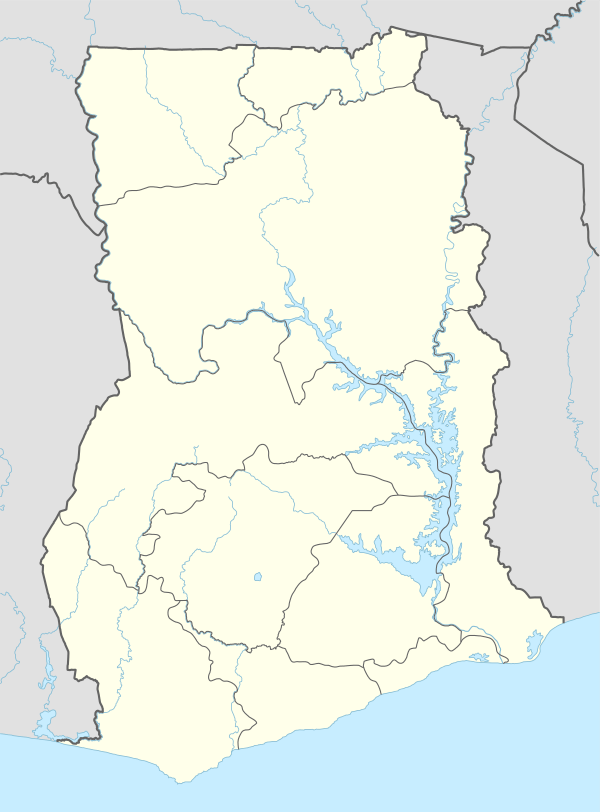Ghana Army
| Ghana Army | |
|---|---|
| Founded |
29 July 1959 – present (57 years, 4 months) |
| Country |
|
| Allegiance | Constitution of Ghana |
| Branch | GAF Army Military Branch |
| Type | Army |
| Role | Ground Warfare |
| Part of |
|
| Colors | Scarlet, Black and Dartmouth Green |
| Commanders | |
| Chief of the Army Staff | Major General Richard Opoku-Adusei |
The Ghana Army (GA) is the main ground warfare organizational military branch of the Ghanaian Armed Forces (GAF). In 1959, two years after the Gold Coast obtained independence as Ghana, the Gold Coast Regiment was withdrawn from the Royal West African Frontier Force, and formed the basis for the new Ghanaian army. Together with the Ghanaian air force (GHF) and Ghanaian navy (GN), the Ghanaian army (GA) makes up the Ghanaian Armed Forces (GAF), controlled by the Ghanaian Ministry of Defence (MoD) and Central Defence Headquarters, both located in Greater Accra.
History

The command structure for the army forces in Ghana originally stemmed from the British Army's West Africa Command. Lieutenant General Lashmer Whistler was the penultimate commander holding the command from 1951 to 1953. Lt Gen Sir Otway Herbert, who left the West Africa Command in 1955, was the last commander.[1] The command was dissolved on 1 July 1956.[2]
In 1957, the Ghana Army consisted of its headquarters, support services, three battalions of infantry and a reconnaissance squadron with armoured cars. Total strength was approximately 5,700 men.[3] Partially due to an over-supply of British officers after the end of the Second World War, only 12% of the officer corps in Ghana, 29 officers out a total of 209 in all, were black Ghanaians at independence.[4] Under Major General Alexander Paley, there were almost 200 British Ghanaian officers and 230 warrant officers and senior commissioned officers posted throughout the Ghanaian Army.
Ghanaian Prime Minister Kwame Nkrumah wished to rapidly expand and Africanise the army in order to support his Pan-African and anti-colonial ambitions. Thus in 1961, 4th and 5th Battalions were established, and in 1964 6th Battalion was established, from a parachute unit originally raised in 1963.[5] Second Infantry Brigade Group was established in 1961 to command the two battalions raised that year. However, 3rd Battalion was disbanded in February 1961 after an August 1960 mutiny while on Operation des Nations Unies au Congo service at Tshikapa in the Democratic Republic of the Congo.[6] The changeover from British to Ghanaian officers meant a sudden lowering of experience levels, training and professionalism.
The Ghanaian commanding officer of 3rd Battalion, Lieutenant Colonel David Hansen, had on appointment as battalion commander only seven years of military experience, compared to the more normal twenty years' of experience for battalion commanders in Western armies. He was badly beaten by his troops during the mutiny.[7] 4th Battalion was raised under a British commanding officer, Lieutenant Colonel Douglas Cairns, from the single company of the 3rd Battalion that had not mutinied.
Initial British planning by Paley before his departure in 1959 had provided for all British officers to be withdrawn by 1970; however, under pressure from Nkrumah, Paley's successor Major General Henry Alexander revised the plans, seeing all British personnel to depart by 1962. However, in September 1961, Alexander and all other British officers and men serving with the Ghanaian armed forces were abruptedly dismissed.[8] Nkrumah was determined to indigenize his armed forces fully, after some years of accelerated promotion of Ghanaian personnel.
Simon Baynham says that “the wholesale shambles which surely must have resulted from simply expelling the expatriate contract and seconded officers was averted by the arrival of Canadian military technicians and training officers.”[9] Canadian training team personnel were assigned to the Military Academy (1961−1968), the Military Hospital, as Brigade Training Officers (1961−1968), to the air force, and later the Ministry of Defence (1963−1968), Ghana Army Headquarters (1963−1968) and the Airborne School.[10]
Matters deteriorated further after the coup that deposed Nkrumah. Colonel James Bond, the Canadian military attache, asked to write a report on how Canada could further assist the Ghanaian armed forces, wrote that 'during 1966 the preoccupation of.. senior officers with their civilian duties as members of the National Liberation Council and as regional administrators, resulted in an unconscious neglect of the welfare of the Army.'[11] Available able intermediate level officers had been assigned civilian administrative duties, leaving the army short.
Ghana has contributed forces to numerous UN and ECOWAS operations, including in the Balkans, Afghanistan, Democratic Republic of the Congo, Lebanon, and Liberia (ECOMOG and UNMIL). Ghana contributed UN peacekeeping in UNAMIR during the Rwandan Genocide. In his book Shake Hands with the Devil, Canadian force commander Romeo Dallaire gave the Ghanaian soldiers high praise for their work during the conflict, in which the Ghanaian contingent lost 3 soldiers.
Structure
 |
The Ghana army is divided into three (3) brigade sized "commands":
- Northern Command (Tamale)
- 6th Battalion, Ghana Regiment
- Airborne Force (One company sized formation each in Upper West and Upper East regions respectively).
- Central Command (Kumasi)
- 3rd Battalion, Ghana Regiment (Sunyani)
- 4th Battalion, Ghana Regiment (Kumasi)
- 2nd Reconnaissance Armoured Squadron (Sunyani)
- 2nd Signal Squadron (Kumasi)
- 2nd Field Workshop (Kumasi)
- 49th Engineer Regiment (Kumasi)
- 2nd Field Ambulance (Kumasi)
- 2nd Transport Company (Kumasi)
- 2nd Field Operations Center (Kumasi)
- Southern Command (Accra)
- 1st Battalion, Ghana Regiment (Tema)
- 2nd Battalion, Ghana Regiment (Takoradi)
- 5th Battalion, Ghana Regiment (Accra)
- 64th Infantry Regiment (Accra)
- 1st Reconnaissance Armoured Squadron and Reconnaissance Armoured Regiment HQ (Accra)
- 66th Artillery Regiment (Ho)
- 48th Engineer Regiment (Teshie)
- 1st Field Workshop (Accra)
- 1 Motor Transport Battalion (Accra)
Infantry
The Ghanaian Army consists of three distinct infantry elements:
- Ghana Regiment – The major element of the army is the six light infantry battalions of the Ghana Regiment. Three battalions are assigned to each brigade.
- Airborne Force – The Airborne Force (ABF) is a battalion sized formation including a parachute trained company assigned to the Northern Command.
- 64 Infantry Regiment – 64 Infantry Regiment is the commando trained rapid reaction force assigned to the Southern Command (formerly known as President's Own Guard Regiment).
Combat Support

The Ghanaian Army has a number of units designated as combat support, including its armour, artillery, engineers and signals:
- Reconnaissance Armoured Regiment
- 48 Engineer Regiment (Teshie, Greater Accra Region)
- 49 Engineer Regiment
- 66 Artillery Regiment (Volta Barracks, Ho; formed 2004 from previous Medium Mortar Regiment)
- Signals Regiment (Accra)
- Logistics Group
Chiefs of the Army Staff
The head of the Ghana Army was formerly referred to as the army commander but now has the title above. The list of former heads lies below.[12]
| Chief of the Army Staff | Conscription | Note |
|---|---|---|
| Brigadier D. H. Tadman | Brigade Commander | |
| Major General A. G. V. Paley | ? – 1960 | First designated army commander |
| Major General Henry Templer Alexander | 1960 – 1961 | Combined CDS with army commander |
| Brigadier Joseph Arthur Ankrah | Dec 1961 – Oct 1962 | First native Ghanaian commander |
| Major General S. J. A. Otu | Oct 1962 – Jul 1965 | |
| Brigadier A. K. Ocran | Feb 1966 – Aug 1966 | |
| Major General Cleland Cofie Bruce | Aug 1966 – May 1967 | |
| Major General A. K. Ocran | May 1967 – Nov 1968 | |
| Brigadier D. C. K. Amenu | Nov 1968 – Aug 1969 | |
| Major General D. K. Addo | Aug 1969 – Jun 1971 | |
| Brigadier J. R. K. Acquah | Jun 1971 – Oct 1971 | |
| Brigadier H. D. Twum-Barimah | Oct 1971 – Jan 1972 | |
| Colonel Emmanuel Alexander Erskine | Jan 1972 – Feb 1972 | |
| Brigadier D. A. Asare | Feb 1972 – Jan 1973 | |
| Brigadier E. A. Erskine | Feb 1973 – Apr 1974 | |
| Brigadier Fred W. K. Akuffo | May 1974 – Nov 1976 | |
| Brigadier and later Major General Robert Kotei | Nov 1976 – Jul 1978 | |
| Major General Neville Alexander Odartey-Wellington | Jul 1978 – Jun 1979 | Died in office |
| Brigadier Joseph Nunoo-Mensah | Jun 1979 – Jul 1979 | |
| Brigadier Arnold Quainoo | Jul 1979 – Nov 1979 | |
| Brigadier I. K. Amoah | Nov 1979 – Dec 1981 | |
| Brigadier/Major General Arnold Quainoo | Jan 1982 – Jun 1987 | |
| Major General W.M. Mensah-Wood | Jun 87 – Jun 90 | |
| Brigadier Ben K. Akafia | Jun 1990 – Jan 1992 | |
| Major General Ben K. Akafia | Jan 1992 – Sep 1996 | |
| Major General J. H. Smith | Oct 1996 – Feb 2001 | |
| Major General Clayton Naa Boanubah Yaache | Feb 2001 – Jun 2005 | |
| Major General Samuel Anum Odotei | 20 May 2005 – 2009 | |
| Major General Joseph Narh Adinkra | 31 Mar 2009 – 4 April 2013 | |
| Major General Richard Opoku-Adusei | 4 April 2013 – present[13] | |
Rank structure

The GA rank structure is similar to the British army ranks structure, they are arranged in descending order:
Officer ranks
- General
- Lieutenant-General
- Major-General
- Brigadier-General
- Colonel
- Lieutenant-Colonel
- Major
- Captain
- Lieutenant
- Second Lieutenant
Enlisted ranks
- Chief Warrant Officer
- Warrant Officer Class 1
- Warrant Officer Class 2
- Staff Sergeant
- Sergeant
- Corporal
- Lance-Corporal
- Private
References
- ↑ Generals.dk
- ↑ Hansard, Defence: West Africa
- ↑ Christopher R. Kilford, The Other Cold War: Canada's Military Assistance to the Developing World 1945-75, Canadian Defence Academy Press, Kingston, Ontario, 2010, p.138
- ↑ Kilford, 137
- ↑ Simon Baynham, The Military and Politics in Nkumrah's Ghana, Westview, 1988, Chapter 4
- ↑ For the Tshikapa mutiny see Henry Alexander, African tightrope. My two years as Nkrumah's Chief of Staff (Pall Mall Press, London, 1965) p.67-71
- ↑ Kilford, 141
- ↑ Kilford, 140
- ↑ Baynham, 1988, p.125
- ↑ Kilford, 141, citing Gary Hunt, “Recollections of the Canadian Armed Forces Training Team in Ghana, 1961-1968, Canadian Defence Quarterly, April 1989, 44
- ↑ Kilford, 156, citing Canada, LAC, “Discussion Paper – Canadian Forces Attaché – Ghana Armed Forces and Canadian Military Assistance,” 12 July 1967, 2. RG 25, External Affairs, Vol. 10415, File 27-20-5 Ghana (Part 4).
- ↑ "Past Army Commanders / Chiefs of Army Staff". Official Website. Ghana Armed Forces. 2008-02-06. Retrieved 2008-10-31.
- ↑ "Chief of Army Staff-COAS Profile of Major General Richard Opoku-Adusei". Ghana Armed Forces. Retrieved 2014-04-23.
Further reading
- Lt Col Festus B Aboagye, The Ghana Army: A Concise Contemporary Guide to its Centennial Regimental History, 1897–1999, Sedco Publishing, Accra, 1999
External sources
- Official Website of the Ghana Armed Forces
 Media related to Military of Ghana at Wikimedia Commons
Media related to Military of Ghana at Wikimedia Commons

